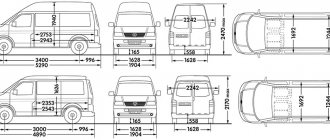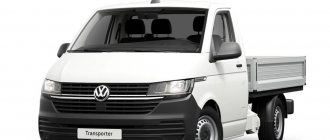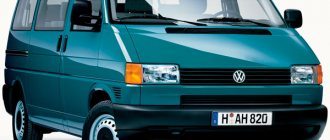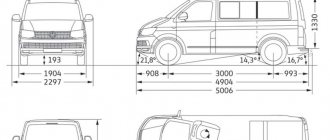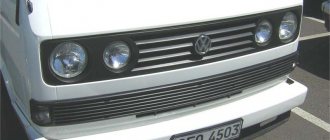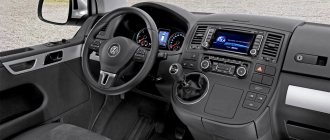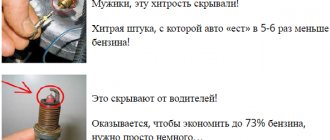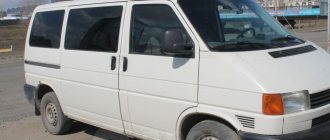Technical characteristics of Volkswagen Transporter T4
contents
Model VW Transporter T4 is a modern unit with a full set of new developments. It was produced from 1990 to 2003. Technical characteristics of the Volkswagen Transporter T4 have undergone changes in all respects over the course of 13 years of production. The car is represented by the largest number of models, varying in:
- engine power and fuel type;
- configurations;
- purpose.
This model range was discontinued 15 years ago, but despite this, you can find cars with 25 years of service in excellent condition. In addition to the owner’s good care of his equipment, this is due to the excellent corrosion protection of the body. This is especially noticeable in the example if we consider which is better: Volkswagen Transporter or Ford Transit. The latter, which is not inferior in its parameters to VW, has 2 drawbacks: rapid corrosion of the body and poor supply of spare parts. And only thanks to constructive continuity, VW models are free of all these shortcomings, despite the fact that they have been out of production for 15 years.
Another pleasant bonus will be the opportunity to find out that the cars produced by the concern in the period 1990-2000 have a high margin of safety, and many buyers prefer the 4th generation model when choosing.
Volkswagen Transporter T4
Fantastic Four"
With such impressive luggage, the Caravel set out on a free voyage. As production progressed, the equipment became more modern. In 1990, production of the fourth generation began, and at the same time the T4 Caravelle. The first difference between all fours is the location of the engine relative to the body.
Previously, the “heart” of the car was located at the rear, but now the engine has taken its place in the front. Cars were produced with both front-wheel drive and all-wheel drive. The main difference between the updated Caravel and the basic Transporter was the panoramic glazing. Although in terms of design sophistication, cars have diverged greatly for a long time. Be that as it may, it was this generation that had the greatest success.
More on the topic: Skoda LIAZ: trucks from Czechoslovakia
Technical characteristics of T4 Caravel
T4 Caravelle was produced for fifteen years - a considerable period by automotive standards. Continuing the tradition of minibuses for every taste, the car came with a dozen different engines. The simplest of them were 1.9 liter engines. Gasoline engines had a diesel backup.
T4 Caravel: comfort comes first.
Their power was only 68 hp with a maximum torque of 140 Nm starting from 2000 rpm. The indicator is not bad and very economical - 8 liters of fuel per 100 km. Then the line went on increasing: 78, 88,102,110,115 and 140, 150 hp. The only model with 204 hp. It was petrol (AI-95). Among its characteristics are:
- V6 engine with four valves and a displacement of 2.8 liters;
- High fuel consumption - from 13 liters;
- Acceleration to 100 km in 12.4 seconds, top speed – 194 km/h;
- Torque 245 Nm at 2500 rpm;
Most models were equipped with a manual transmission, but versions with 204 hp, 2.8 liter (140 hp) and 2.5 liter (115 hp) petrol engines were also supplied with an automatic transmission. The car was produced in two versions: short wheelbase (4789 mm) and long wheelbase (5189 mm). But the trunk volume on both versions is the same – 540 liters. Permissible weight varies from 1800 to 2800 kg.
According to the characteristics of the VW Caravelle T4, it is a typical 4-door minivan that can carry up to 7 people. In 1996, six years after the start of production of the car, restyling began. Externally, the front of the Caravella has changed: the “nose” has become longer and rounded, the design of the bumper has changed (fog lights were installed in it), the headlights have changed shape. The Caravella T4 interior received brand new comfortable seats, a weighty steering wheel, a tachograph, an immobilizer, a rear windshield wiper and automatic air conditioning.
As mentioned above, cars are equipped with disc brakes, sometimes in combination with drum brakes. Ground clearance of 150 mm is ideal for the city and, at the same time, has a small margin for emergency situations. The car has not been produced since 2005, for Russian drivers this is rather a plus - used copies are much cheaper than new ones. The average price of cars is about 500 thousand rubles.
T4 Caravel is equipped with everything necessary for relaxation: tables, drawers for things, a radio, comfortable wide armchairs.
Specifications
By the nature of its operation, despite the overall dimensions of the Volkswagen Transporter T4, it is a passenger car: maneuverable, compact and lightweight. Along with this, the VW T4 is equipped with a chassis with a high margin of safety and excellent maintainability. The dimensions of the Volkswagen Transporter T4 depend on the body type, which is usually divided into three types:
- Passenger - up to 9 seats.
- Cargo-passenger - 3-5 seats.
- Cargo - 3 places.
The curb weight of the vehicle is 1580 kg. The permissible loading weight must not exceed 2580 kg. For the Volkswagen Transporter, body dimensions vary over a wide range, which determines the body type:
- width: large - 1840 mm, reduced - 1620 mm;
- length: standard - 5107 mm, reduced - 4789 mm;
- height: standard - 1900 mm, reduced - 1350 mm, increased - 1940 mm.
As already mentioned, VW models are highly resistant to corrosion. This is achieved thanks to the technology of aging steel after stamping, galvanizing parts and using mixtures to increase the adhesion of the paint and varnish coating to the metal surface.
Device
The body is a solid steel frame, where all parts are rigidly connected by welding. All types use a cargo-type platform, which is connected to the frame with bolted fasteners. The Volkswagen Transporter T4 is distinguished by its radiator grille, which characteristically stands out above the original plastic insert. It is worth noting that even then the modular assembly of removable parts (doors, wings, hood) was used for their convenient and high-quality replacement. The windshield on the Volkswagen Transporter T4 is beveled, providing good visibility.
Volkswagen Transporter T4 interior
Everything is well thought out in terms of safety:
- The driver's row of seats is structurally separated from the passenger row. In the event of a frontal impact, the force is partially absorbed by elements of the engine compartment; in the case of a side impact, the force is partially absorbed by reinforced inserts of the side doors and pillars.
- The visibility for the driver has been improved, and the dashboard of the Volkswagen Transporter T4, to which the gearshift lever has been moved, has become more ergonomic.
- Each element determines its location as accurately as possible - the angle of the panel, the distance between the instruments, color lighting and the display system - which allows minimal distraction of the driver’s attention from the road and control.
As with all VW models, the weight distribution is stable and even, ensuring even axle loads. The loading volume can be further increased by installing a roof rack on the Volkswagen Transporter T4.
Overall dimensions of Volkswagen Transporter T4
Chassis
Starting with these models, front-wheel drive is installed, but a well-proven visco coupling ensures all-wheel drive on difficult sections of the route (ice, mountainous terrain, off-road, rough terrain).
New axle with independent front suspension. The Volkswagen Transporter T4 torsion bar or spring rear suspension and low-frame chassis provide high shock absorption and reduced floor load.
Engine
The engine determines the main characteristics of the car. This is the first line in which the installation of a V-1.8 carburetor engine was stopped and the installation of diesel units began. The first modification in which the engine is already located in front. The power range is 60-115 hp. s., 4 and 5 cylinders, respectively, as many as glow plugs on the Volkswagen Transporter T4.
Engine 1.9TD Volkswagen Transporter T4
Modification of engines installed in cars of different configurations and determining the fuel consumption of the Volkswagen Transporter:
- Diesel engines. The fuel consumption of the Volkswagen Transporter T4 DD is significantly less, given the increased traction power, for which they have no equal. They are indispensable in rough and mountainous terrain, where descents and ascents predominate.
| Modification | Number of cylinders/V | Power, l. With. | Consumption 90 km/h/GC, l |
| TR 1.9D | 4 / 1896 | 60 | 8,9 |
| TR 1.9 TD | 4 / -/- | 68 | 9,0 |
| TR 2.4 D | 5 / 2370 | 78 | 9,4 |
| Tr 2.5 TDI DNVT | 5 / 2461 | 102 | 9,1 |
| Tr 2.5 TDI DNVT | 5 / 2461 | 88 | 8,9 |
- Gasoline engines. Their resource is 500-700 km higher. They fail less often and allow you to reach higher speeds, up to 164 km/h.
| Modification | Number of cylinders/V | Power, l. With. | Consumption 90 km/h/GC, l |
| TR 2.0 | 4 /1968 | 84 | 11,7 |
| TR 2.5 | 5 /2461 | 115 | 13,4 |
The model is equipped with a 5-speed manual transmission; on the Volkswagen Transporter T4, starting with the 3rd generation car, the engine is installed in a transverse position and is water-cooled.
Brake system
Front and rear brakes can be fully disc or combined: front disc and rear drum. Ventilated discs are installed on Ø 15″ wheels. The system itself consists of a master cylinder and a 2-circuit system (one circuit ensures that 2 wheels stop diagonally). The vehicle is reinforced with a vacuum device and a pressure regulator. ABS is installed on the front wheels.
Features of the Volkswagen Transporter T4 brake system
Performance indicators
Actual fuel consumption may differ from the nominal one due to the long production resource
The maximum speed that a VW can achieve is 132-164 km/h. Acceleration speed to 100 km is 16-24 seconds. Consumption on the highway is much lower, but in the urban cycle it averages up to 10 l/100 km.
Despite the fact that these cars are considered “indestructible”, and they feel great on Russian roads, they still have a number of specific features.
For example, a running system in which the following often fails:
- oil seals;
- steering rods;
- depressurization of the power steering;
- ball joints;
- wheel bearings;
- stabilizer.
Diesel engine problems:
- Injection pump - fuel pump, depressurization and loss of fluid;
- replacement of spark plugs and glow system;
- turbocharger;
- fuel injection system.
For petrol models Volkswagen Transporter T4, fuel system:
- ignition coils;
- starter.
Volkswagen Transporter T4 is widely used in various fields
Model types and applications
In the Transporter T4 series there are varieties of vehicles that differ in purpose and configuration, but the main difference between them is the body type:
- Panel Van is a truck with blank sides that imitate windows.
- Kombi Van, Half-Panel - a cargo-passenger van, has several options for glazing the side windows. In the first, it is presented without side glazing; in some models, the rear door can be glazed; it can also be hinged or lifting. The second option is presented with side glazing between the 2nd and 3rd pillars. The car has 5 passenger seats.
- Caravelle, Multivan - maximum comfort. Passenger car with full visibility, with 2 or 3 rows of passenger seats. The driver's row and passenger compartment are separated and represent separate zones. This increases technical safety and eliminates factors that distract the driver from the road. The first passenger row of seats rotates around its axis, forming a compartment-type salon. Between them there is a folding movable table next to the cup holders. The seats are adjustable back and forth. The back row folds out to create a sleeping area.
- Westfalia is a camper modification. There are such devices as a gas stove, dry closet, cabinets, shelves. Double glazed windows are installed to maintain a uniform temperature. The lifting roof increases transport volume and provides ventilation.
- DoKa - cargo-passenger transportation, model with a double cab (5 seats) of a truck.
- Pritschenwagen is a cargo van with 3 passenger seats.
After studying the instruction manual for the Volkswagen Transporter T4, you can understand all the features of the vehicle.
Conclusion
VW 4th generation is the most successful modification, which is in demand for all areas of activity. Today, such equipment can only be purchased on the secondary market, but even there, thanks to the excellent quality, the cost of these machines is in the range of 1.5-15 thousand dollars. The rarest modifications are camping ones. They were produced in limited editions, so their prices are quite high. The price for the latest VW T6 models in full premium configuration reaches up to 120 thousand euros.
In all Transporter models, the main emphasis is on comfort, and the large price range for the car is another advantage for buyers.
Years of production of T4 Caravel: detailed description of the model range
Retrospective and today T4 Volkswagen Caravel
The history of the Transporter begins in the post-war period, namely in 1947. It was this year that the Dutchman Ben Paul came up with the idea of a cargo minibus based on the Beetle passenger car he saw. Paul thought hard about the prospects and, having sketched out sketches, went straight to the chief director of the company with his proposal. He supported the idea - to restore Europe after the war, new forces and decisions were required.
A comfortable van with the function of transporting a large number of passengers was called a minibus. And two years later the model was presented at an official event. Thus the Volkswagen Transporter series was born. The first generation was a resounding success.
The progenitor of the T4 Caravel is the first Volkswagen Transporter model, a legacy of the Beetle model.
This was largely due to the unusual expressive appearance and constantly updated modifications. As the director of the company, Heinrich Nordhov himself, said: “Like the Volkswagen Beetle, our car knows no compromises...”. In the first generation, the vehicle was produced for 25 years; numerous service vans were developed on its basis and passenger and camping versions were produced.
Technical progress Volkswagen Transporter
Over the entire history of the Volkswagen Transporter series, the car has seen the whole world. In addition to the fact that most of the German cars were exported, production also expanded. Already for the production of T1, a plant was opened in Brazil. From the second generation to this day, production continues in Argentina, Poland, South Africa and even in Russia.
Increasing load capacity and functionality has always remained the main goal for Volkswagen. Modifications grew, and with them the technical improvement of vans. Since the late sixties, Volkswagen received a dual-circuit braking system, and a little later acquired disc brakes. In 1972, an automatic transmission with three speeds appeared on the cars. In many ways, the rapid re-equipment can be associated with the highest competition in the light-duty vehicle segment, where for a long time the Ford Transit truck was one of the most popular.
More on the topic: IFA W50L – an echo of history
The 80s updated the car in terms of electronic systems. Electric window lifts, central locking, an ABS system, windshield wipers and headlight washers, and interior heating appeared. Diesel engines were installed alongside gasoline ones. Diesel versions were marked with the letter "D" in the name.
In 1979, production of the T3 officially began, which largely determined the future path of development of the Volkswagen Transporter. And in 1981, a number of changes occurred, both in the names of the cars and in the trim levels. It was during this period that the first Caravelle came out - velor seat upholstery, multi-colored body, fabrics in the interior, in a word, luxury. In general, I must say there were two luxury modifications: the second was called Bus. Details of the car's configuration can be seen in the video review:
Bus was produced from the very beginning of the third generation. The design included chrome wheels, bumpers, tilt glass, passenger air ducts and armrests. With the advent of the Caravelle, the name Bus ceased to be used. Now everything beyond the basic set bore a new, light and elegant name - Caravel.
A business version of the Caravelle Carat with a lowered suspension, wide tires, and alloy wheels was produced separately. In the salon there was a table with lighting for reading and working, and there was also multimedia of that time - a radio with the function of playing audio cassettes. The seats in the car were single and had armrests, electric lifts and power steering were included as standard.
